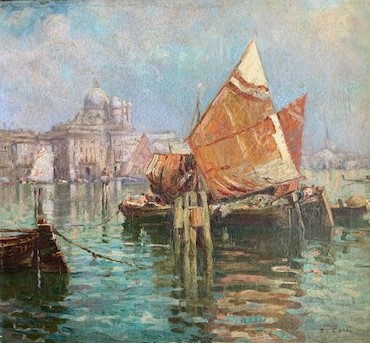
Oil on canvas. 24 x 28 in.
Venice by James Howe Carse
Born in Edinburgh, Scotland, James Howe Carse, the son of Alexander Carse, known as ‘Old Carse,’ emerged from a lineage of Scottish painters. Alexander, renowned for Scottish genre scenes from 1802 to 1838, likely inspired James Howe’s artistic path. James Howe Carse was named after the contemporary Scottish animal painter, James Howe. Although the details of his birth remain elusive, historical accounts place it around 1818 or 1819.
Trained at the Royal Scottish Academy, James exhibited landscape paintings in London between 1860 and 1862. Notably, “An Old Mill on the Avon near Bathgate, Looking towards the Firth of Forth,” showcased in 1860, marked his presence. His London residence during this period was at 24 Edward Terrace, Caledonian Road North. In 1867, James Howe Carse likely arrived in Australia, initially seen in South Australia and later exploring Victoria and New Zealand by 1869.
In 1869, his artwork, including “Riddell’s Creek, Mount Macedon,” gained recognition in Melbourne, and he contributed to Edwin Carton Booth’s “Australia Illustrated.” The engravings in this publication, attributed to ‘J. Carr,’ highlighted diverse Australian and New Zealand landscapes.
A pivotal figure in the Australian art scene, Carse became a founding member of the Victorian Academy of Arts in Melbourne in 1870. His sojourn in New South Wales commenced in 1871, where he adopted various aliases, including J.H. Carr and James Carr. His contributions to the New South Wales Academy of Art earned him a certificate of merit in 1872 for “Weatherboard Falls.”
In 1873, Carse secured the Hon. John Campbell’s prize for “Loch Oich and Inverary Castle, Scotland.” This accolade underscored his ability to capture the sublime beauty of landscapes. He continued to exhibit prolifically, earning certificates of merit for works like “Bega Swamps” in 1875.
Carse’s reputation soared in 1876, winning a gold medal for his depiction of “Weatherboard Falls” and displaying genre scenes like “The Morning Herald” and “The Evening News.” The following year, he was lauded as ‘perhaps the best painter in the colony’ and faced critique for his use of vibrant greens in landscapes like “The Jump-Up, Road into Burragorang.”
A foundational member of the Art Society of New South Wales since its inception in 1880, Carse focused on painting the south coast’s scenic views. Over the years, his submissions to the society’s exhibitions waned, with critics noting a departure from his earlier brilliance.
In the latter part of his life, Carse resided in Mosman Bay, possibly with his longtime friend, the painter George Podmore. Unfortunately, his life was marred by alcoholism, leading to his demise in 1900. His extensive body of work, primarily in oils, reflects a quiet romanticism, often portraying the interplay between humans and nature. His legacy endures, capturing the essence of Australian landscapes with a unique artistic vision.